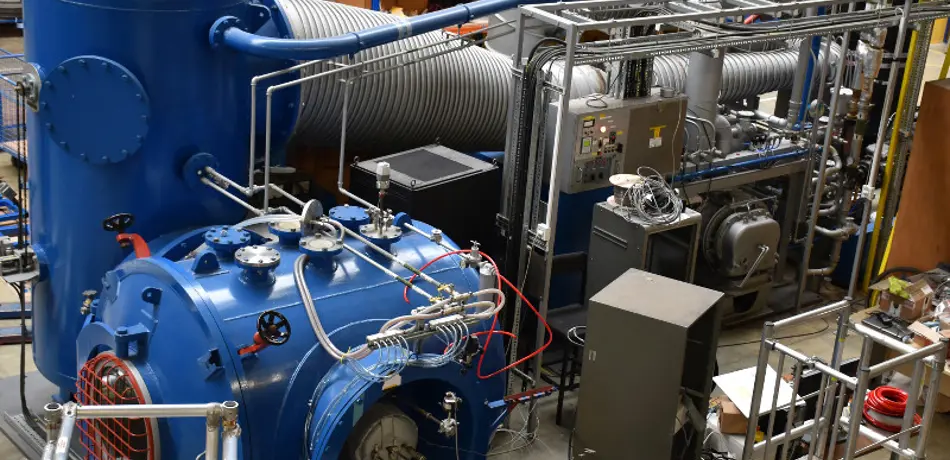Oxford Thermofluids Institute | Facilities - Hypersonic Facilities: Low Density Tunnel

Low Density Tunnel

The Low Density Tunnel (LDT) is rarefied flow facility, with the ability to produce flows with high Knudsen numbers representative of those experienced in the slip regime.
The facility is continuous and is capable of measuring aerodynamic coefficients by use of a magnetic suspension balance.
Specifications:
- Knudsen numbers up to 0.3
- Max p0 = 200 kPa
- Max T0 = 600 K
- Contoured Mach 6 nozzle, 30-60 mm core flow
- Mach 5-10 conical nozzle with 20-50 mm core flow
- Magnetic force balance
- 2 axis wake traverse
- 3 axis traverse for model re-orientation
Instrumentation:
- Video cameras capable of imaging at over 1 million frames/s
- Free flight data acquisition hardware
- High powered lasers and associated diagnostics
- High speed light sources for visualisation
- Emission spectroscopy equipment from the visual to mid-wave infrared
- High bandwidth pressure transducers
- High response heat flux gauges and signal conditioning
University of Oxford Low Density Wind Tunnel
A unique facility for the future of hypersonic and space research
The video features the Low Density Wind-tunnel (LDWT) which is part of the EPSRC backed National Wind Tunnel Facility. The video features the LDWT’s Magnetic Balance and Suspension System, and demonstrates how lift, drag and heat transfer are measured on magnetically levitated test models. It also highlights projects conducted in the facility related to Mars Pathfinder planetary re-entry and Hyper-X scramjet flight testing. The video was the result of a collaboration between Dr. Andrew Owen, Senior Researcher in the Oxford Thermofluids Institute, Dr. Kevin Owen, Complere Inc. and Dr. Robert Danziger.
Mars Pathfinder
Mass and drag were the limiting factors for the Pathfinder mission. Mars atmosphere is 1/100th the density of earth. Pathfinder had to enter at the right speed and angle or it could burn up, be thrown off course, or even skip back into space. The Martian atmosphere had to be used to slow down Pathfinder from 12,000 mph to 0 before landing using its heat shield, parachutes and retro-rockets. Pathfinder had to pause fifty feet above the surface to lower the Martian rover safely to the ground. When entering the Martian atmosphere, the spacecraft withstood temperatures on its heat shield of 1600 degrees C, even while the air pushed to its sides reached temperatures of over 5,000 degrees C. Pathfinder landed perfectly.
The video shows comparative drag data, side-by-side pictures of the tests at Oxford, actual footage from Pathfinder as it landed on Mars, and the extraordinary and unique image of Pathfinder landing that was coincidentally taken by an orbiting satellite. Pathfinder video and animation provided by JPL/Cal-Tech, JPL’s original “back-of-the-envelope” drawings and actual control room voices during Pathfinder Entry, Descent and Landing are included in the presentation.
HYPER-X, X-43: Fastest Aircraft on Record
Scramjets only operate at speeds in the range of Mach 4.5 or higher, because at these speeds “engines compress the air prior to combustion using the ram effect as the air slows down on meeting the vehicle.” SCRAMJETS (Supersonic Combustion Ramjets) have been studied since the 1960’s in Oxford wind tunnels. (Hypersonics at Osney Lab, by Terry Jones, SOUE News, 2003).
In 2004 the X-43 achieved first flight of a thrust-producing scramjet powered vehicle with full aerodynamic maneuvering surfaces, and “became the fastest free flying air-breathing aircraft in the world.” A later X-43 set several new airspeed records, including the fastest aircraft at Mach 9.6 (7,000 mph). Launched from a Pegasus rocket riding under the wing of a converted B-52 bomber, the HYPER-X “stack” separates from the launching aircraft, falls a safe distance away, fires the rocket to accelerate the X-43 to above Mach 4.5 – then the X-43 separates from the rocket, falls a safe distance away, and fires up its scramjet. Separating smoothly, swallowing the intake shock of air appropriately, and handling the intense heat is critical to success. The Low Density Wind Tunnel played a key role in critical X-43/Pegasus rocket separation studies.
The video has historic footage of the first use of Mag-Lev on a model X-43 aircraft (non-axisymmetric body) in a hypersonic wind tunnel, pre-flight animations, and video and control room audio of the actual flight.
Current and Future Work:
Orbital Debris Re-entry Aerothermodynamics
Recently, the Low Density Wind Tunnel has been used by Dr Nathan Donaldson to study the heat transfer to orbital debris during the early stages of re-entry. Orbital debris has accumulated over the past 63 years of the space age and poses an increasing risk to modern society which is inextricably dependent on space-based services. Understanding the aerothermodynamic environment of space debris will help to ensure that the satellites of yesteryear don’t pose a threat to continued orbital access and that the satellites of tomorrow are designed to demise shortly after their end-of-life. Plans are currently being developed to further enhance the capability of the Low Density Wind Tunnel to enable research and innovation on orbital debris, thereby positioning the facility at the forefront of this burgeoning field of research.
Credits
- Video Produced by Dr. Robert Danziger (2020)
- Dr. Andrew Owen’s research was supported by DERA (Farnborough) under contract 2057-158.
- Hyper-X research was conducted in conjunction with Dr. Kevin Owen and Complere, Inc. with support from NASA Langley Research Center under contract L-6756.
- Images, video and sound provided by: Andrew Owen, Kevin Owen, University of Oxford, NASA, Jet Propulsion Laboratory/Cal-Tech.
- Recent work on the LDWT has been led by Dr. Luke J Doherty- Senior Research Fellow in Hypersonics.
- Nathan L. Donaldson’s doctorate was supported by the STFC, EPSRC and Fluid Gravity Engineering Ltd.
Music
- Brandenburg 32-3 Woodland
- Brandello 31 (by the Brandenburg 300 Project; arranged and performed by Robert Danziger)
- Nursery Suite, by Edward Elgar (arranged and performed by Robert Danziger)

